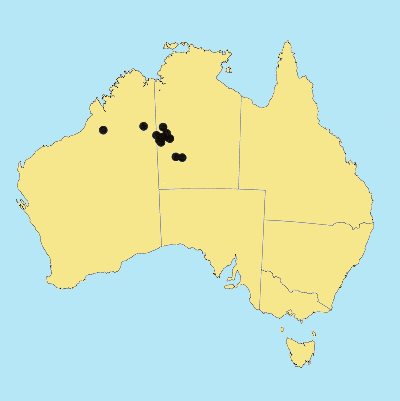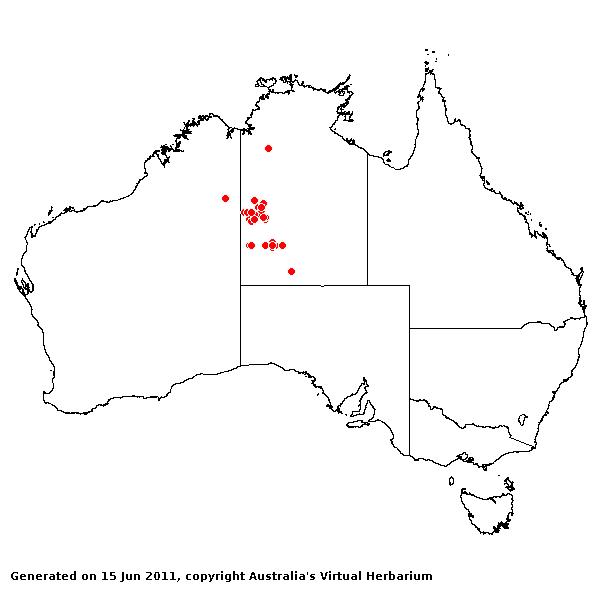Triodia salina M.
Lazarides. Austral. Syst. Bot.
10: 471 (1997).
Classification. (GPWG 2001) : Subfamily
Chloridoideae. Triodeae.
Type of Basionym or
Protologue Information: Northern Territory: Northern Central Australia;
Lake Bennett, Lat. 22º45' S, Long. 131º01' E, 18 Jan 72, P.K. Latz 2108
(HT: CANB; IT: BRI, NT, PERTH).
Key references
(books and floras): [2002] D.Sharp & B.K.Simon, AusGrass, Grasses of
Australia.
Illustrations:
[2005] K.Mallet (ed.), Flora of Australia 44B: Poaceae 3 (Fig. 34D-F).
Habit.
Perennial. Stolons present. Culms 30–160 cm tall. Lateral branches fastigiate.
Leaf-sheaths smooth, glabrous on surface. Leaf-sheath auricles absent. Ligule a
fringe of hairs, 0.5–0.8 mm long. Leaf-blades straight, filiform, conduplicate,
9–27 cm long, 0.8–1.2 mm wide.
Inflorescence.
Inflorescence compound, a panicle. Panicle linear, dense or loose, 17–40 cm
long, 1–2.5 cm wide.
Spikelets.
Spikelets pedicelled. Fertile spikelets many flowered, with at least 2 fertile
florets (4–7), comprising 4–7 fertile floret(s), with diminished florets at the
apex, cuneate, laterally compressed or terete, 10–12 mm long.
Glumes.
Glumes similar, thinner than fertile lemma. Lower glume lanceolate, scarious,
much thinner on margins, keeled, 1-keeled, 1–7 -nerved. Lower glume surface
glabrous. Lower glume apex muticous or mucronate or awned. Upper glume
lanceolate, 8–17 mm long, scarious, keeled, 1-keeled, 1–7 -nerved. Upper glume
surface smooth or asperulous, glabrous. Upper glume apex entire, muticous or
mucronate or awned.
Florets.
Fertile lemma 3–4 mm long, without keel or keeled. Lemma surface glabrous or
indumented. Lemma apex lobed, awned, 3 -awned. Median (principal) awn 5–10 mm
long overall. Lateral lemma awns present. Lodicules present. Anthers 3. Grain 2
mm long.
Continental
Distribution: Australasia.
Australian
Distribution: Western Australia, Northern Territory.
Western Australia:
Hall, Dampier. Northern Territory: Victoria River, Central Australia
North.
Notes.
Distinguished by its bitextured palea with winged keels; thickened yellowish
lemmas with spreading hairs; heavily resinous foliage; elongated usually narrow
panicle. Resembling P. pungens but without the transversely demarcated
lemma of that species, and with a smaller spikelet, spreading (not appressed)
lemma hairs and entirely acute, scaberulous-ciliolate palea keels (not partly
rounded and smooth).
Between
lats. 20°-23°S and W of long. 132°E in the N.T., and adjacent parts of W.A. in
the Great Sandy Desert. In or near saline salt-pans, salt-lakes, sandhill
swales, soaks and depressions, in deep red soils (sands, sandy loams and clay
loams) associated with laterite and limestone; flowers recorded in Jan.-Feb.,
Apr., and persisting until July-Aug.; fruits recorded in Jan.-Feb., Apr., and
persisting until July-Aug.



